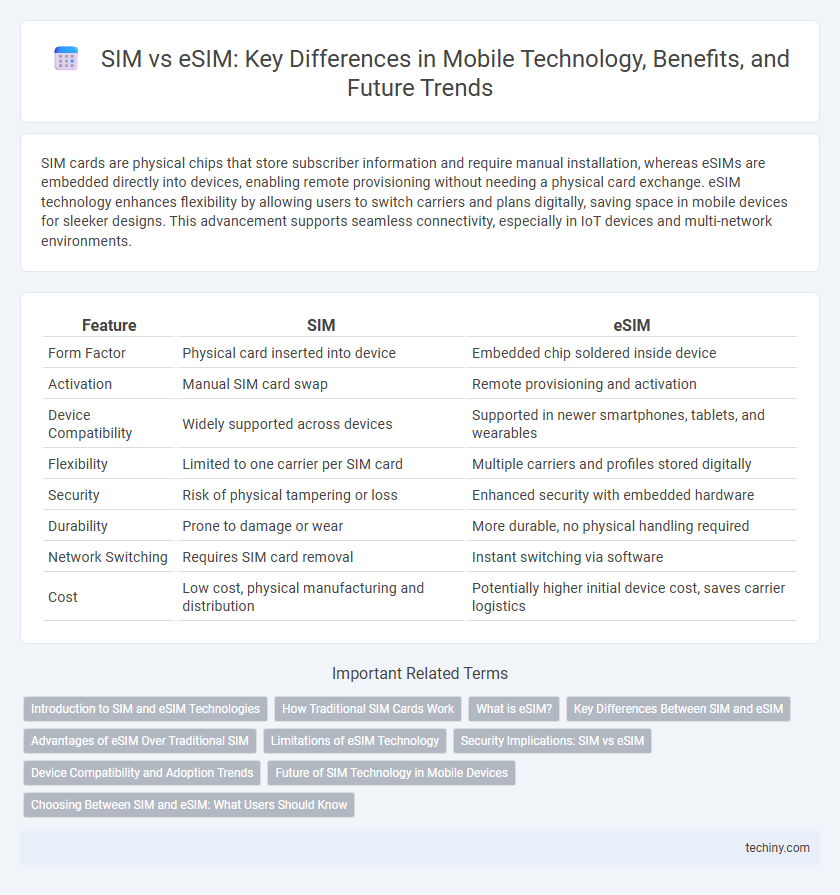SIM cards are physical chips that store subscriber information and require manual installation, whereas eSIMs are embedded directly into devices, enabling remote provisioning without needing a physical card exchange. eSIM technology enhances flexibility by allowing users to switch carriers and plans digitally, saving space in mobile devices for sleeker designs. This advancement supports seamless connectivity, especially in IoT devices and multi-network environments.
Table of Comparison
| Feature | SIM | eSIM |
|---|---|---|
| Form Factor | Physical card inserted into device | Embedded chip soldered inside device |
| Activation | Manual SIM card swap | Remote provisioning and activation |
| Device Compatibility | Widely supported across devices | Supported in newer smartphones, tablets, and wearables |
| Flexibility | Limited to one carrier per SIM card | Multiple carriers and profiles stored digitally |
| Security | Risk of physical tampering or loss | Enhanced security with embedded hardware |
| Durability | Prone to damage or wear | More durable, no physical handling required |
| Network Switching | Requires SIM card removal | Instant switching via software |
| Cost | Low cost, physical manufacturing and distribution | Potentially higher initial device cost, saves carrier logistics |
Introduction to SIM and eSIM Technologies
SIM (Subscriber Identity Module) cards are physical chips inserted into mobile devices to store subscriber information and enable network connectivity. eSIM (embedded SIM) technology integrates this functionality directly into the device's hardware, allowing remote provisioning and eliminating the need for a physical card. Both SIM and eSIM facilitate device authentication and mobile network access, but eSIM offers enhanced flexibility for switching carriers and managing multiple profiles digitally.
How Traditional SIM Cards Work
Traditional SIM cards store subscriber identity and authentication information, enabling mobile devices to connect to cellular networks. They physically slot into a device, allowing users to switch phones by transferring the SIM card. This technology relies on removable hardware, limiting flexibility compared to embedded eSIMs that are programmed digitally within the device.
What is eSIM?
eSIM, or embedded SIM, is a digital SIM card embedded directly into a mobile device, eliminating the need for a physical SIM card. It enables remote provisioning of cellular plans, allowing users to switch carriers or plans without swapping cards. eSIM technology supports multiple profiles, enhances device design by saving space, and simplifies connectivity for smartphones, tablets, and IoT devices.
Key Differences Between SIM and eSIM
SIM cards are physical chips inserted into mobile devices, storing subscriber information and enabling network connectivity, whereas eSIMs are embedded chips soldered directly onto the device's motherboard, programmable for multiple carriers without swapping cards. Unlike traditional SIMs, eSIM technology supports remote provisioning, allowing users to switch carriers or plans digitally through software without needing a physical card change. The key differences lie in format, flexibility, and ease of network management, with eSIMs offering greater convenience for device manufacturers and consumers in the mobile technology landscape.
Advantages of eSIM Over Traditional SIM
eSIM technology offers significant advantages over traditional SIM cards, including the ability to store multiple carrier profiles on a single device, which enhances flexibility and convenience for users who travel frequently or switch carriers. Its embedded design eliminates the need for physical card insertion, improving device durability and reducing the risk of SIM card loss or damage. eSIMs also enable remote provisioning and activation, streamlining the process for both consumers and network operators while supporting the growing demand for connected devices in the Internet of Things (IoT) ecosystem.
Limitations of eSIM Technology
eSIM technology faces limitations such as limited compatibility with older devices and restricted carrier support, which can hinder seamless adoption worldwide. The inability to easily swap eSIM profiles like physical SIM cards complicates device transfers and secondary device usage. Security concerns also arise due to the remote provisioning process, potentially exposing users to cyber threats without adequate safeguards.
Security Implications: SIM vs eSIM
Physical SIM cards store sensitive user data on removable chips vulnerable to loss, theft, or cloning, posing security risks. eSIMs embed the subscriber identity securely within the device, enabling remote provisioning and enhanced encryption protocols that reduce exposure to physical tampering. The integrated design of eSIMs improves resilience against unauthorized access and enables faster implementation of security updates compared to traditional SIMs.
Device Compatibility and Adoption Trends
SIM cards remain widely compatible with a vast majority of mobile devices globally, especially older smartphones and feature phones, ensuring broad user accessibility. eSIM technology, integrated directly into devices, is gaining rapid adoption in flagship smartphones, wearables, and IoT gadgets due to its flexibility and remote provisioning capabilities. Market data highlights a steady increase in eSIM-enabled device shipments, with manufacturers and carriers driving ecosystem support to enhance user convenience and device interoperability.
Future of SIM Technology in Mobile Devices
The future of SIM technology in mobile devices is shifting towards eSIM adoption, enabling seamless connectivity without the need for physical SIM cards. eSIMs provide enhanced security, remote provisioning, and greater flexibility for users to switch carriers or plans instantly. As mobile technology evolves, eSIM integration supports the growing demand for IoT devices, wearables, and multi-device ecosystems, positioning it as the key standard in mobile connectivity.
Choosing Between SIM and eSIM: What Users Should Know
Choosing between SIM and eSIM depends on device compatibility and user convenience, as eSIM offers enhanced flexibility by allowing multiple profiles without physical card swaps. SIM cards require physical insertion and removal, making them ideal for users who frequently switch devices or travel internationally. eSIM technology supports remote provisioning, reducing the need for plastic cards and enabling seamless carrier switching, which benefits tech-savvy consumers seeking streamlined mobile connectivity.
SIM vs eSIM Infographic

 techiny.com
techiny.com